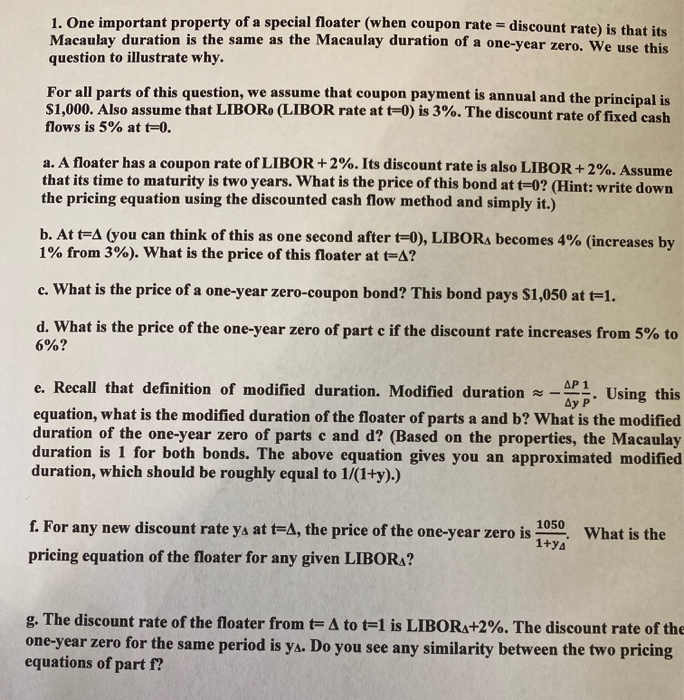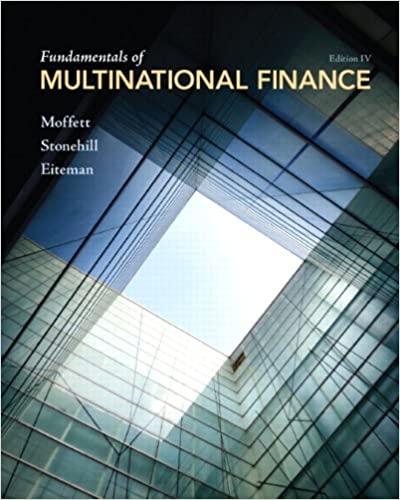
need help on finding part b
1. One important property of a special floater (when coupon rate = discount rate) is that its Macaulay duration is the same as the Macaulay duration of a one-year zero. We use this question to illustrate why. For all parts of this question, we assume that coupon payment is annual and the principal is $1.000. Also assume that LIBORI (LIBOR rate at t-0) is 3%. The discount rate of fixed cash flows is 5% at t=0. a. A floater has a coupon rate of LIBOR +2%. Its discount rate is also LIBOR +2%. Assume that its time to maturity is two years. What is the price of this bond at t=0? (Hint: write down the pricing equation using the discounted cash flow method and simply it.) b. At t-A (you can think of this as one second after t=0), LIBORA becomes 4% (increases by 1% from 3%). What is the price of this floater at t-A? c. What is the price of a one-year zero-coupon bond? This bond pays $1,050 at t=1. d. What is the price of the one-year zero of part c if the discount rate increases from 5% to 6%? e. Recall that definition of modified duration. Modified duration - - Using this equation, what is the modified duration of the floater of parts a and b? What is the modified duration of the one-year zero of parts c and d? (Based on the properties, the Macaulay duration is 1 for both bonds. The above equation gives you an approximated modified duration, which should be roughly equal to 1/(1+y).) 1050 1+ya f. For any new discount rate ya at t=A, the price of the one-year zero is pricing equation of the floater for any given LIBORA? What is the g. The discount rate of the floater from A to t=1 is LIBORA+2%. The discount rate of th one-year zero for the same period is ya. Do you see any similarity between the two pricing equations of part f? 1. One important property of a special floater (when coupon rate = discount rate) is that its Macaulay duration is the same as the Macaulay duration of a one-year zero. We use this question to illustrate why. For all parts of this question, we assume that coupon payment is annual and the principal is $1.000. Also assume that LIBORI (LIBOR rate at t-0) is 3%. The discount rate of fixed cash flows is 5% at t=0. a. A floater has a coupon rate of LIBOR +2%. Its discount rate is also LIBOR +2%. Assume that its time to maturity is two years. What is the price of this bond at t=0? (Hint: write down the pricing equation using the discounted cash flow method and simply it.) b. At t-A (you can think of this as one second after t=0), LIBORA becomes 4% (increases by 1% from 3%). What is the price of this floater at t-A? c. What is the price of a one-year zero-coupon bond? This bond pays $1,050 at t=1. d. What is the price of the one-year zero of part c if the discount rate increases from 5% to 6%? e. Recall that definition of modified duration. Modified duration - - Using this equation, what is the modified duration of the floater of parts a and b? What is the modified duration of the one-year zero of parts c and d? (Based on the properties, the Macaulay duration is 1 for both bonds. The above equation gives you an approximated modified duration, which should be roughly equal to 1/(1+y).) 1050 1+ya f. For any new discount rate ya at t=A, the price of the one-year zero is pricing equation of the floater for any given LIBORA? What is the g. The discount rate of the floater from A to t=1 is LIBORA+2%. The discount rate of th one-year zero for the same period is ya. Do you see any similarity between the two pricing equations of part f
 need help on finding part b
need help on finding part b 





